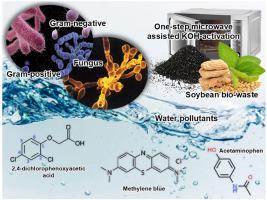Environmental Research ( IF 7.7 ) Pub Date : 2021-09-10 , DOI: 10.1016/j.envres.2021.112044 Kah Yee Lim 1 , Keng Yuen Foo 1

|
In this work, the transformation of soybean industrial bio-residue with limited practical applications, into a multifunctional carbonaceous adsorbent (SBAC) via one-step microwave-irradiation has been succeeded. The surface porosity, chemical compositions, functionalities and surface chemistry were featured by microscopic pore-textural analysis, elemental constitution analysis, morphological characterization and Fourier transform infra-red spectroscopy. The adsorptive performance of SBAC was evaluated in a batch experiment by adopting different classes of water pollutants, specifically methylene blue (MB), acetaminophen and 2,4-dichlorophenoxyacetic acid (2,4-D). The equilibrium uptakes were analyzed with respect to the non-linearized Langmuir, Freundlich and Temkin isotherm equations. The unique features of SBAC, specifically the antimicrobial and antifungal efficacies were examined against gram-positive/negative bacteria and fungi species. An ordered microporous-mesoporous structure of SBAC, with the BET surface area and total pore volume of 1696 m2/g and 0.94 m3/g, respectively, has been achieved. The equilibrium data of MB and acetaminophen were found to be in good agreement with the Langmuir isotherm model, with the monolayer adsorption capacities (Qo) of 434.57 mg/g and 393.31 mg/g, respectively. The adsorptive experiment of 2,4-D was best fitted to the Freundlich isotherm equation, with the Qo of 253.17 mg/g. The regeneration performance of the spent SBAC under microwave-irradiation could maintain at 69.42–79.31%, even after five (5) adsorption-regeneration cycles. SBAC exhibited excellent inhibition efficiencies against gram-positive/negative bacteria and fungi species, with the inhibition zones at 14.0–28.0 mm. This newly developed SBAC appears to be a new powerful candidate for the remediation of different classes of water contaminants, and novel antibacterial and antifungal agents against biological contaminations. The novel concept of “turn waste into wealth” in a cost-effective and energy saving manner for environmental preservation has been successfully accomplished.
中文翻译:

微波加热从大豆生物残渣中一步合成碳质吸附剂:吸附、抗菌和抗真菌行为
在这项工作中,通过一步微波辐射成功地将实际应用有限的大豆工业生物残留物转化为多功能碳质吸附剂(SBAC)。通过微观孔隙结构分析、元素组成分析、形态表征和傅里叶变换红外光谱对表面孔隙率、化学成分、功能和表面化学进行了表征。通过采用不同类别的水污染物,特别是亚甲蓝(MB)、对乙酰氨基酚和2,4-二氯苯氧基乙酸(2,4-D),在批量实验中评估了SBAC的吸附性能。根据非线性 Langmuir、Freundlich 和 Temkin 等温方程分析平衡吸收。 SBAC 的独特功能,特别是针对革兰氏阳性/阴性细菌和真菌物种的抗菌和抗真菌功效进行了检查。 SBAC具有有序的微孔-介孔结构,BET比表面积和总孔容分别为1696 m 2 /g和0.94 m 3 /g。 MB和对乙酰氨基酚的平衡数据与Langmuir等温线模型非常吻合,单层吸附容量( Q o )分别为434.57 mg/g和393.31 mg/g。 2,4-D的吸附实验最符合Freundlich等温方程, Q o为253.17 mg/g。即使经过五 (5) 次吸附再生循环,废 SBAC 在微波辐射下的再生性能仍可保持在 69.42–79.31%。 SBAC对革兰氏阳性/阴性细菌和真菌表现出优异的抑制效率,抑制范围为14.0-28.0 mm。这种新开发的 SBAC 似乎是修复不同类别水污染物以及针对生物污染的新型抗菌和抗真菌剂的强大候选者。以经济高效、节能环保的方式“变废为宝”的新颖理念已成功实现。











































 京公网安备 11010802027423号
京公网安备 11010802027423号